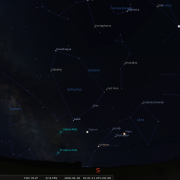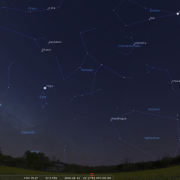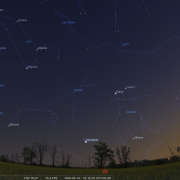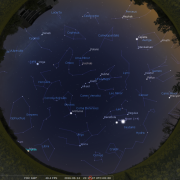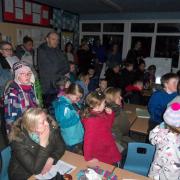Welcome to the WDAS monthly newsletter for May 2016: a digest of the month's latest contributions to our website. Below you'll find Society News, Sky Notes and In-Focus articles printed in full. There's also future events, and trailers for other articles which appear in full on the website - just a click away!
On the website you'll also be able to comment on articles, and if you'd like to play an editorial role in creating new content, just let us know!
Quick Summary for May:
- WDAS Society Meeting on Tuesday 3rd April from 19:30h. The final meeting of the season, with traditional quiz.
- Star Parties on 14th and 28th May. Please lend a hand if you can.
Society News
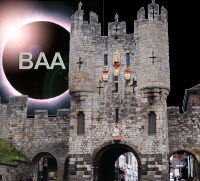 Four WDAS Members have already booked or the British Astronomical Association Summer Meeting in York on July 2nd. If you'd like to go too, please contact andi
Four WDAS Members have already booked or the British Astronomical Association Summer Meeting in York on July 2nd. If you'd like to go too, please contact andi![]() whitby-astronomers.com and we'll see if we can arrange for another car.
whitby-astronomers.com and we'll see if we can arrange for another car.
The ticket cost, for WDAS Members, is a miniscule £5.00, for which you get to see five talks on Cosmology, on a theme "Probing the Dark Side of the Universe".
See more details of talks and speeakers in the Events section.
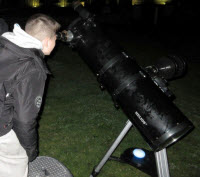 Initially requested by Libby Lavelle, assistant Head teacher of Ayresome Primary school in Middlesbrough, the original plan was to host a star party for her visiting group of two dozen 10 and 11 year old pupils at Whitby Youth Hostel, near the Abbey on March 29th. This was however postponed on the night itself, the weather was lousy, but the forecast ahead looked promising.
Initially requested by Libby Lavelle, assistant Head teacher of Ayresome Primary school in Middlesbrough, the original plan was to host a star party for her visiting group of two dozen 10 and 11 year old pupils at Whitby Youth Hostel, near the Abbey on March 29th. This was however postponed on the night itself, the weather was lousy, but the forecast ahead looked promising.
So it was mutually agreed to trade in the rain of Tuesday for the forecast clear skies of Thursday. For once this proved an extremely good call. Thursday evening was clear, clear enough for several hours at least, affording views of Jupiter and allow a laser point tour of the early spring sky. The location (we all agreed) also enhanced proceedings, the large courtyard in front of the Abbey visitor’s centre. The adjoining Abbey wall and access lane to the centre and Hostel ideal for propping our posters boards against and demonstrating the scale solar system, that has never looked so linear, clear and organised.
Along with the 10” Dobsonian (Mark’s), Keith and Lee provided the other scopes allowing all to enjoy varied views of Jupiter and the Orion Nebula. The evening was just what Libby hoped for – an opportunity for the children to experience a darker sky and look through a telescope, and judging by the reaction of the pupils, thoroughly appreciated.
Boggle Hole YHA Event Footnote
And now here’s the flip side of the observing coin. The event planned for Boggle Hole YH on April 5th was cancelled, again by mutual agreement, due to the forecast. Timing, timing is everything on all too many occasions, and on this occasion the god-damn lousy, atrocious weather throughout the day, scooted off into the North Sea earlier than forecast, allowing a god-damn beautiful clear evening to prevail. What a let-down, the most frustrating of wrongly timed forecasts, and a wasted opportunity. That’s how it works out sometimes.
Sky Notes
In this month's Sky Notes:
Planetary Skylights

 May is a busy month in the planetary calendar this year. Mars reaches opposition toward the end of the month, whilst Mercury, which after a fine April showing (if it hadn’t been so cloudy early on) transits across the face of the Sun on May 9th.
May is a busy month in the planetary calendar this year. Mars reaches opposition toward the end of the month, whilst Mercury, which after a fine April showing (if it hadn’t been so cloudy early on) transits across the face of the Sun on May 9th.
Transit of Mercury

Observing the transit:
Solar filter method
Let us start with this. Transits of Mercury are more frequent than a transit of Venus, although there are still only around 13 Mercury transits in any given century. Transits of Mercury occur in either May or November. May transits are rarer than November ones, with Mercury appearing slightly larger for the May events (12" vs. 10") as it is near its aphelion point. Even 12 arc seconds is very small, consequently the silhouette of Mercury’s tiny disk is not visible through eclipse glasses or solar shades.
Unless you have, and are familiar with the use of authentic solar filters used in conjunction with a small telescope (not screw on eyepiece type filters) then the best and safest way to view the transit is by the projection method.
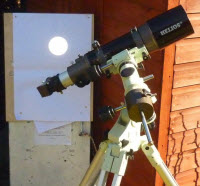
Observing the transit:
Projection Method
Observations involving the Sun always come with a health warning; so you must exercise care at all times. Do not attempt shortcuts. To project the Sun’s image onto a white surface, such as a piece of paper, a small refractor or reflector up to 3"- 4” in aperture is preferable. Anything larger may be susceptible to aperture damage.
Point the telescope at the sun without looking into it. This can be achieved by watching the shadow of the telescope while moving it until the shadow is minimized. Then, hold a paper (or any other white surface) several inches in front of the eyepiece. A white blob should be projected onto the paper. Focus the image until this blob becomes a distinct circle - this is the projected image of the sun.
 It may help to shade the image and/or create a fixture to hold the paper. Look for a perfectly spherical black dot – that’s Mercury, the innermost planet, a heavily cratered body like the moon and just over 3100 miles in diameter. Any fuzzy irregular black patches visible on the Suns disk will be sunspots, which in reality will be several times larger than Mercury.
It may help to shade the image and/or create a fixture to hold the paper. Look for a perfectly spherical black dot – that’s Mercury, the innermost planet, a heavily cratered body like the moon and just over 3100 miles in diameter. Any fuzzy irregular black patches visible on the Suns disk will be sunspots, which in reality will be several times larger than Mercury.
The encouraging thing about this transit as far as observations go is that it lasts over seven hours, and you would hope that over that time frame the sun will be visible at some point. Let’s be positive. From our latitude and location the transit commences shortly before 12:15h and lasts until 19:38h. Mid transit occurs mid afternoon. The next three Mercury transits;- 2019, 2032 and 2039 are November transits. After this one, the next May transit won't occur until May 7, 2049. Good luck and safe viewing.
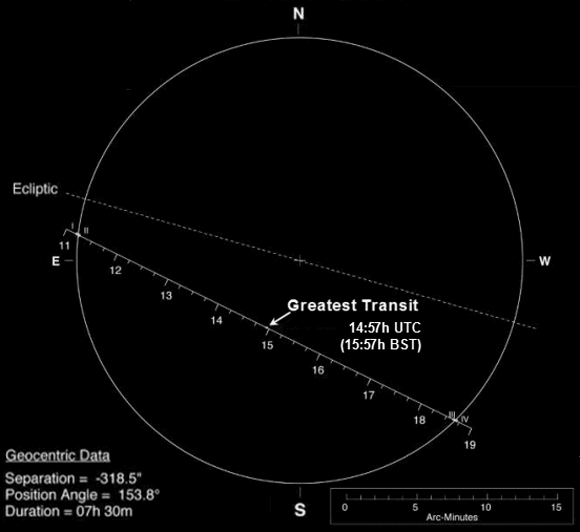
Oberving the Transit of Mercury, 09-May-2016.
Times on the chart are given in UTC (GMT). Add one hour for BST.
Society Transit Observations
We have not made definite plans as to where to observe the transit on the day. For post college times, i would assume the observatory would be an obvious choice, perhaps 16:30-19:00h. By the time of our society meeting on May 3rd, more interesting concrete plans for afternoon observations, currently being formulated with other parties should be forthcoming.
Mars at Opposition
Mars finally reaches opposition on May 22nd, when it lies directly opposite the Sun in the sky, rising as the sun sets and residing due south at local midnight, low above the horizon in the constellation of Scorpios. The red planet is however closest to Earth, and hence appear slightly larger, a whopping 18 arc seconds in diameter, on the 30th. But before we get carried away with this size, remember Jupiter always exhibits a disk size of over 40 arc seconds, so the Martian disk is really quite small.
As May progresses, the orange hue of Mars should become quite conspicuous low to the Southeast to South by 23:00h. Mars is currently in retrograde motion, i.e. moving east to west against the background stars. With Mars residing just above Scorpius, look for its ‘rival’, Antares, chief star in the Scorpian, which also exhibits an orange hue.
Although this opposition is better than the last and the next one in 2018 will be better still, the location of Mars in the sky makes for less than perfect observations. Mars like all the planets follow the ecliptic, which unfortunately during late spring and summer resides quite close to southern horizon. Any observations will therefore be hampered by the band of more turbulent air found close to the horizon. Images will boil and shimmer, and you will have to exercise patience, waiting for those fleeting seconds of steadier seeing.
First time viewers of the red planet will also have to curtail their expectations: even at a very favourable opposition, Mars appears only half the size of Jupiter, so no, it won’t be as big as a ‘full moon’ and you won’t see ‘Martian canals’. You will, however be looking at the surface of Mars, the only other planet we can do so, and provided seeing is reasonable, surface feature should be discernable. Look for the Martian Ice caps and darker surface areas; in particular the fin shaped Syrtis Major. The red planet will be at its best from May 15th to June 15th.
 Mars may receive all the attention this month, however Jupiter still reigns supreme in the late evening sky, being much brighter than Mars. Jupiter resides high to the south as twilight deepens, but as the month progresses it drops down into the west, setting in the post midnight hours. Unlike Mars, Jupiter is always a rewarding target through a telescope; the banding across the disk, and dance of the attendant Galilean moons make for fascinating observation. Jupiter resides above our moon on the 15th.
Mars may receive all the attention this month, however Jupiter still reigns supreme in the late evening sky, being much brighter than Mars. Jupiter resides high to the south as twilight deepens, but as the month progresses it drops down into the west, setting in the post midnight hours. Unlike Mars, Jupiter is always a rewarding target through a telescope; the banding across the disk, and dance of the attendant Galilean moons make for fascinating observation. Jupiter resides above our moon on the 15th.
 Finally, Saturn is the bright pearly white ‘star’ to the left of Mars, making for a nice colour contrast. Point any scope at Saturn and you will see the glorious ring system, though again, because of the low altitude you will have to be patient for tho se knoc kout steady views. The moon passes Mars and Saturn on the 21st – 22nd.
Finally, Saturn is the bright pearly white ‘star’ to the left of Mars, making for a nice colour contrast. Point any scope at Saturn and you will see the glorious ring system, though again, because of the low altitude you will have to be patient for tho se knoc kout steady views. The moon passes Mars and Saturn on the 21st – 22nd.
Meteor Showers

The Eta Aquarid meteor shower reaches a peak in the early morning hours of May 5th with rates of 15-25 visible between the hours of 02:00 and 04:00h. Should you be awake and skies are clear, view in any direction but Southeast, this is where Aquarius is just rising. If the radiant of the shower had been higher in the sky at this time of year, rates of 40-50 per hour would not be uncommon. With it being a new moon period, the chances of spotting some early morning shooting stars are still pretty good however.
Incidentally this is one of two meteor showers associated with debris particles deposited over time by comet Halley, the other being the Orionids, which peak in late October.
May 2016 Sky Charts
Click each image to see a full-size Sky Chart:
|
Looking South
Mid May - 22:15h |
Looking North |
|
Looking East
Mid May - 22:15h |
Looking West
Mid May - 22:15h |
|
|
|
|
Overview
9th May - 22:15h |
|
Additional Image Credits:
- Planets and Comets where not otherwise mentioned: NASA
- Sky Charts: Stellarium Software
In-Focus
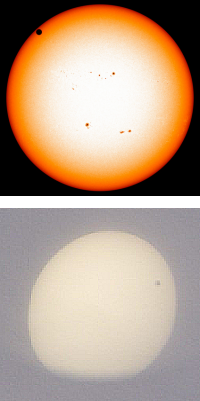
Transit of Venus in 2004
(Bottom: Society Member image)
Both Mercury and Venus are termed inferior planets, as they both orbit around the Sun inside the Earth’s orbit. As inferior planets, on occasion Mercury and Venus can transit across the Sun as seen from the vantage point of Earth. Transits of Venus are extremely rare, occurring in pairs 8 yrs apart separated by intervals of over 100 yrs. A transit of Mercury is less rare, but still only around 13 can occur in any one century. Transits of Mercury can only occur whenever the planet is close to its ascending node or descending node (the points in its orbit where the planet crosses the ecliptic - the apparent path of the Sun against the background stars) heading Northwards or Southwards, respectively. For such an event to take place, the planet must be close to inferior conjunction (i.e. positioned directly between the Earth and the Sun.) and within around 2° of one of these nodes.
At present because of the positioning of the nodes in relation to the Earth's orbit, transits can only occur in the second week of May (descending node) or in the second week of November (ascending node). The ascending and descending nodes of the planets are positioned exactly 180° apart - hence the six-month difference between these two dates. Because the node positions change very slowly over time, dates of Mercury transits drift about 1½ days later per century.
Transits of Mercury at the descending node take place when the Sun and Mercury are positioned in the constellation of Aries, the Ram whilst those at the ascending node take place when the two celestial bodies are positioned in Libra, the scales.
May transits of Mercury repeat at intervals of 13, 33 and 46 years, whilst those in November repeat at intervals of 7, 13 and 46 years. November transits also outnumber May transits in the approximate ratio of 7:3. May transits are slower than November transits because Mercury is then closer to the aphelion point in its orbit (i.e. its furthest point from the Sun) and its orbital speed is therefore slower. November transits are swifter because the planet is then near perihelion (its closest point to the Sun) and so its orbital speed is faster.
The coming transit on May 9th lasts about 2½ hours longer than the previous one in November 2006, with the added bonus for observers that the path of Mercury also passes closer to the Sun's centre and is therefore slightly longer, so that from our location this equates to approximately 7 hours 23 minutes.
Misc
And finally, a few photos from the Fylingdales School event covered in last month's newsletter. For more photos of all our events, check out the 2016 Star Party folder in the gallery!
Events
 Observe the night sky with us at the Bruce Observatory, Whitby School
Observe the night sky with us at the Bruce Observatory, Whitby School
Observing Nights are held weather permitting: check for a relatively clear sky before leaving home. If in doubt, Mark can be reached on 07886069339
Please note the college drive gate is now operated via a electronic key code - so anyone wishing to attend must be at the car park at the top of the drive by 19:00hrs - unless an arrival time has been arranged with Mark/Keith.
 Observe the night sky with us at the Bruce Observatory, Whitby School
Observe the night sky with us at the Bruce Observatory, Whitby School
Observing Nights are held weather permitting: check for a relatively clear sky before leaving home. If in doubt, Mark can be reached on 07886069339
Please note the college drive gate is now operated via a electronic key code - so anyone wishing to attend must be at the car park at the top of the drive by 19:00hrs - unless an arrival time has been arranged with Mark/Keith.
 Observe the night sky with us at the Bruce Observatory, Whitby School
Observe the night sky with us at the Bruce Observatory, Whitby School
Observing Nights are held weather permitting: check for a relatively clear sky before leaving home. If in doubt, Mark can be reached on 07886069339
Please note the college drive gate is now operated via a electronic key code - so anyone wishing to attend must be at the car park at the top of the drive by 19:00hrs - unless an arrival time has been arranged with Mark/Keith.
 Whitby School - Room H1.
Whitby School - Room H1.
In Members' monthly meetings we usually take a tour of the night sky for the coming month using the Planetarium program. Have talks and presentations on various topics of astronomy/space etc, and discuss future events etc. New members welcome.




